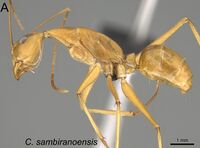Camponotus sambiranoensis
| Camponotus sambiranoensis | |
|---|---|

| |
| Scientific classification | |
| Kingdom: | Animalia |
| Phylum: | Arthropoda |
| Class: | Insecta |
| Order: | Hymenoptera |
| Family: | Formicidae |
| Subfamily: | Formicinae |
| Tribe: | Camponotini |
| Genus: | Camponotus |
| Subgenus: | Myrmosaga |
| Species: | C. sambiranoensis |
| Binomial name | |
| Camponotus sambiranoensis Rakotonirina & Fisher, 2022 | |
Camponotus sambiranoensis is only known to occur in the north of Madagascar. It colonizes the dry forests of Binara, RS Ambre, and RS Ankarana, the transitional forests of Ampasindava and Binara, the rainforests of Makirovana and RS Manongarivo, and the montane forest of RS Manongarivo. This species nests in rotten logs and in the ground, and forages on the ground, in leaf litter, and on low vegetation.
Identification
Rakotonirina and Fisher (2022) - With head in full-face view, lateral cephalic margins converging posteriorly towards eye level; anteromedian margin of clypeus broadly convex; two apical teeth of mandible normally spaced; lateral cephalic margin anterior to eye level without erect hairs.
Camponotus sambiranoensis shares a broadly convex anteromedian margin of clypeus with Camponotus niavo, and Camponotus cervicalis, but in the two latter species the lateral cephalic margin anterior to the eye level is covered with erect hairs.
Keys including this Species
Distribution
Distribution based on Regional Taxon Lists
Malagasy Region: Madagascar (type locality).
Distribution based on AntMaps
Distribution based on AntWeb specimens
Check data from AntWeb
Countries Occupied
| Number of countries occupied by this species based on AntWiki Regional Taxon Lists. In general, fewer countries occupied indicates a narrower range, while more countries indicates a more widespread species. |

|
Estimated Abundance
| Relative abundance based on number of AntMaps records per species (this species within the purple bar). Fewer records (to the left) indicates a less abundant/encountered species while more records (to the right) indicates more abundant/encountered species. |

|
Biology
Castes
Nomenclature
The following information is derived from Barry Bolton's Online Catalogue of the Ants of the World.
- sambiranoensis. Camponotus sambiranoensis Rakotonirina & Fisher, 2022: 161, figs. 6A, 9A, 73 (s.w.) MADAGASCAR.
- Type-material: holotype worker (caste not indicated), 3 paratype minor workers.
- Type-locality: holotype Madagascar: Antsiranana, RS Ankarana, 22.9 km. 224° SW Arivorano Nord, -12.90889, 49.10983, 80 m., 10-16.ii.2001, BLF02880 (B.L. Fisher,C.E. Griswold, et al.); paratypes with same data.
- Type-depositories: CASC (holotype); BMNH, CASC, MHNG (paratypes).
- Distribution: Madagascar.
Unless otherwise noted the text for the remainder of this section is reported from the publication that includes the original description.
Description
Worker
Morphological measurements: see Appendix 1 and Ratios of morphometric data for majors and minors
Minor In full-face view, lateral margins of head converging progressively to level of anterior ocular margin, strongly converging to a short posterior margin behind eye level; eye protruding and large (EL/CS: 0.28±0.01; 0.27–0.29), breaking lateral cephalic border, level of its posterior margin at least at posterior 1/3 of head (PoOc/CL; 0.32±0.04; 0.30–0.42); frontal carinae wide (FR/CS: 0.22±0.0; 0.21–0.23), posteriorly parallel, distance between them larger than smallest distance to eye; clypeus without well-defined anterolateral angle, its anteromedian margin broadly convex or triangular; mandible with two apical teeth closely spaced; antennal scape relatively long (SL/CS: 2.04±0.07; 1.97–2.18). Mesosoma low and long (MPH/ML: 0.33±0.03; 0.28–0.36), with weakly convex promesonotum and approximately flat mesopropodeum; metanotal groove barely visible; propodeal dorsum almost straight or anteriorly slightly convex and posteriorly flat; dorsal margin of propodeum and declivity joined at blunt angle; propodeal declivity 1/3 of length of dorsum. Petiole nodiform, dorsal margin inclined posteriorly, its junction to anterior face bluntly angulate; anterior face of petiolar node 1/2 height of posterior face; femur of hind leg rounded axially, not twisted basally.
First and second gastral tergites without a pair of white spots; lateral margin of head without erect hairs; two erect hairs present near posterior cephalic margin; antennal scape without erect hairs but covered with numerous appressed hairs; pronotum with a pair of erect hairs; posterodorsal angle of propodeum without erect hairs.
Major Differing from minor worker in the following characters: larger head (CS: 4.45; CWb/CL: 0.98); apical 1/4 of antennal scape extending beyond posterior cephalic margin; very robust, short, and high mesosoma, with promesonotum and metanotum forming an even convexity; and propodeal dorsum sloping and joining declivity with blunt angle. Petiolar node much compressed anteroposteriorly, anterior face shorter than posterior.
Type Material
- Holotype worker. MADAGASCAR: Province Antsiranana: RS Ankarana, 22.9 km 224° SW Anivorano Nord, -12.90889, 49.10983, 80 m, tropical dry forest, ex rotten log, 10–16 Feb 2001, (Fisher, Griswold et al.) collection code: BLF02880, collection code: CASENT0428077 (CAS).
- Paratypes. 3 minor workers of the same data as holotype but with the following specimen codes: CASENT0428078, CASENT0428080, CASENT0428079 (NHMUK, MHNG, CAS).
Etymology
The species name sambiranoensis is a Latin singular adjective in the nominative case of masculine gender. This species name refers to the region of Sambirano where the species was found.

